 Over the years, I have had a number of radio people, from all over the country, ask if I had worked at the station in Bellingham that was on top of the drive-in movie theater. Yes, I did! Once, I even described it for a newspaper in California that was doing a story on radio stations with studios in odd locations. KBFW was unique — maybe the only radio station to have been located over a drive-in movie theater.
Over the years, I have had a number of radio people, from all over the country, ask if I had worked at the station in Bellingham that was on top of the drive-in movie theater. Yes, I did! Once, I even described it for a newspaper in California that was doing a story on radio stations with studios in odd locations. KBFW was unique — maybe the only radio station to have been located over a drive-in movie theater.
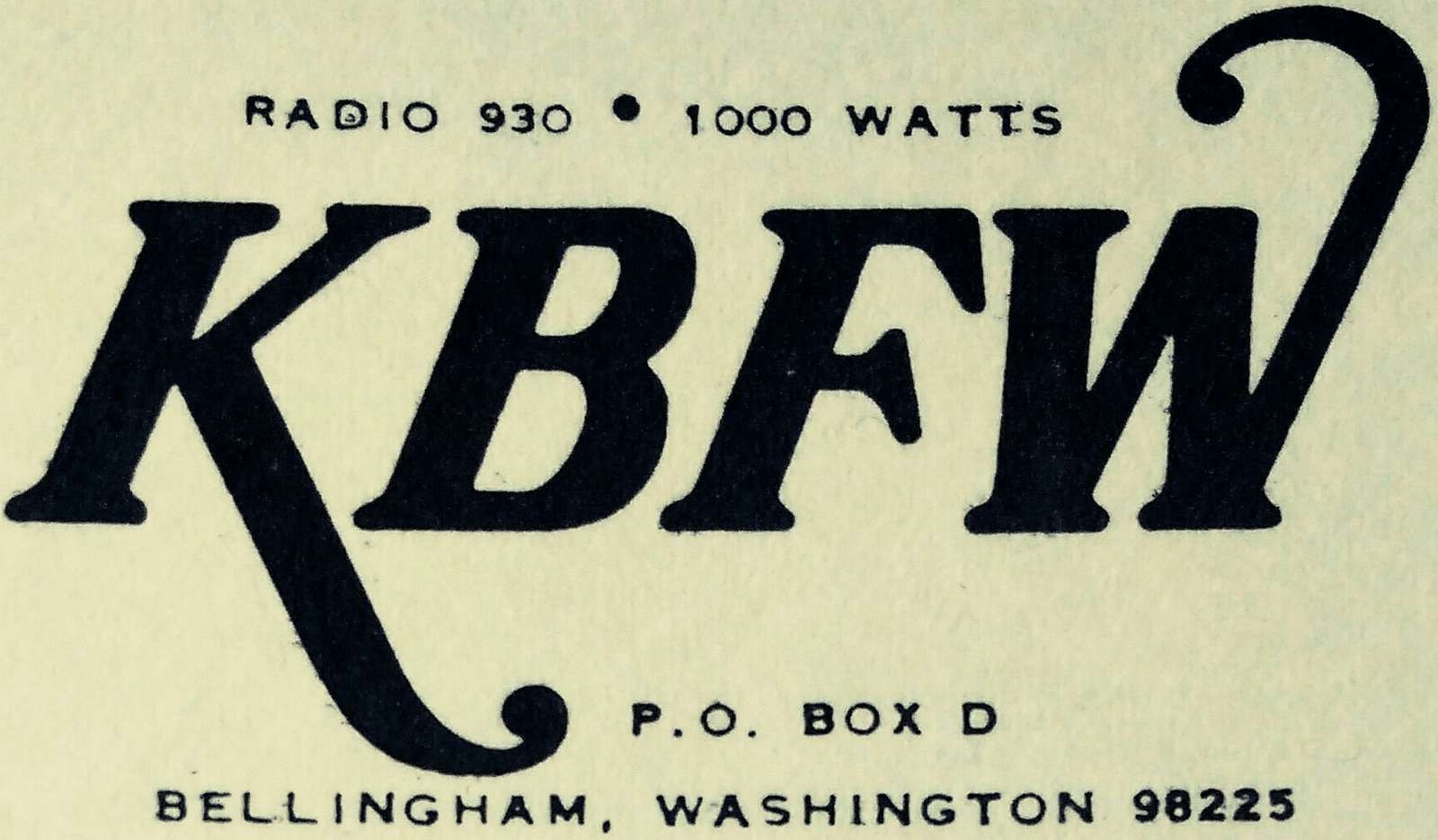
This article is for anybody who ever wondered how a radio station ended up in a movie theater. I worked at KBFW longer than anyone living or dead. And I was at KBFW the whole time it was at the drive-in, except for a six month hiatus at an across town station.
First things first. When I was hired by KBFW, in early June 1972, the studio was located on the top floor of the tallest building in town. The Bellingham Towers was then, and it still is, the highest structure in Bellingham at 157 feet and with 15 floors. But that studio location was about to change, because KBFW was moving.
Take Me Out to the Movies
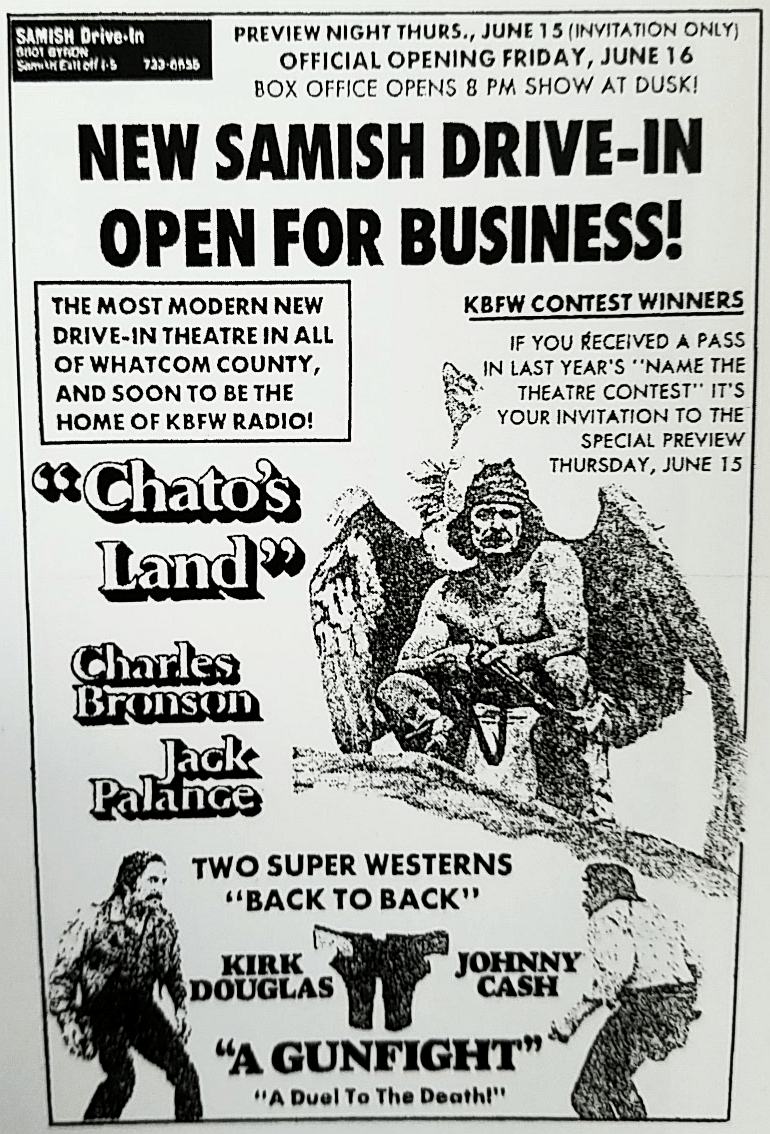

To better understand our move to a theater, you should know that KBFW was owned (personally) by Fred Danz, President of Sterling Recreation Organization, from Bellevue, WA. SRO was the largest group owner of theaters in the state of Washington. Their holdings included movie theaters of all types, bowling alleys and radio stations in Washington, Oregon and eventually California. At one point, the company added Colorado to its mix as well.
The station had a popular country music format. I did three or four air shifts from the top of the towers and that was it. SRO had recently built a new drive-in movie theater in south Bellingham. That theater opened on June 16, 1972. On or about Saturday night, June 17, 1972, we signed off the air one last time from the top of the towers and the staff moved key parts of the station including singles and albums, tape carts, office supplies and typewriters, etc. to the new studio at the drive-in.
The technical part of the move was planned and implemented by Chief Engineer, Bill Hamelin. In the weeks before our big move, the production room had been disassembled and set up at the drive-in. The jocks were still broadcasting as usual from the main control room that was at the top of the towers. We were cutting spots (commercials) at the top of the towers in either the newsroom or in the control room after nightly sign off. The station was at that time a daytimer — we signed off each evening at sundown. Our hours of operation were short in winter and longer in summer. (KBFW began broadcasting 24 hours a day in 1988.)
Logistics of Moving
The most critical engineering issue, on that night of the move, involved two telephone lines. The audio from the studio to the transmitter, and control of the transmitter (across town in the forest) and FCC mandated meter readings, relied on two separate dedicated phone lines from Ma Bell. Once KBFW had signed off from the top of the towers for the last time (9:15 p.m. in the month of June) Bill Hamelin took the studio end audio processing equipment and the remote control to the new drive-in theater studio.

It was midnight by the time the equipment was relocated and wired into the system. That was good timing: At midnight, we were legally able sign back on-the-air for technical purposes and testing. I stayed at the new drive-in studio and Bill went to the transmitter site in the boonies and switched over the audio and control phone lines. Once that was complete, I played a few records from the new studio to see if the audio sent down the equalized phone line sounded okay. Finally, we ran the remote control through its paces turning the transmitter on and off, changing power, verifying the accuracy of meter readings.
Everything worked and, for a few weeks, the jocks broadcast live from the production room at the drive-in. The remaining equipment made its way to the Samish Drive-In and it was wired in and ready to go within a month. (Nearly 20 years later, I used Bill Hamelin’s same technique and sequence of events, even though I did not have to mess with pesky phone lines, when I moved KBFW to the Fountain District in Bellingham.)

The SRO Building and Complex
This next photo was an early shot of the exterior layout of the drive-in theater complex. The building that housed the radio station and the drive-in is off to the right. There is an interesting story. The owner of one of those houses, outside the fence on the left side, was a lawyer. Early on, he told SRO that unless they supplied him with a speaker, so he could watch the movies from his house, he would turn into a nagging neighbor. He got his private speaker.
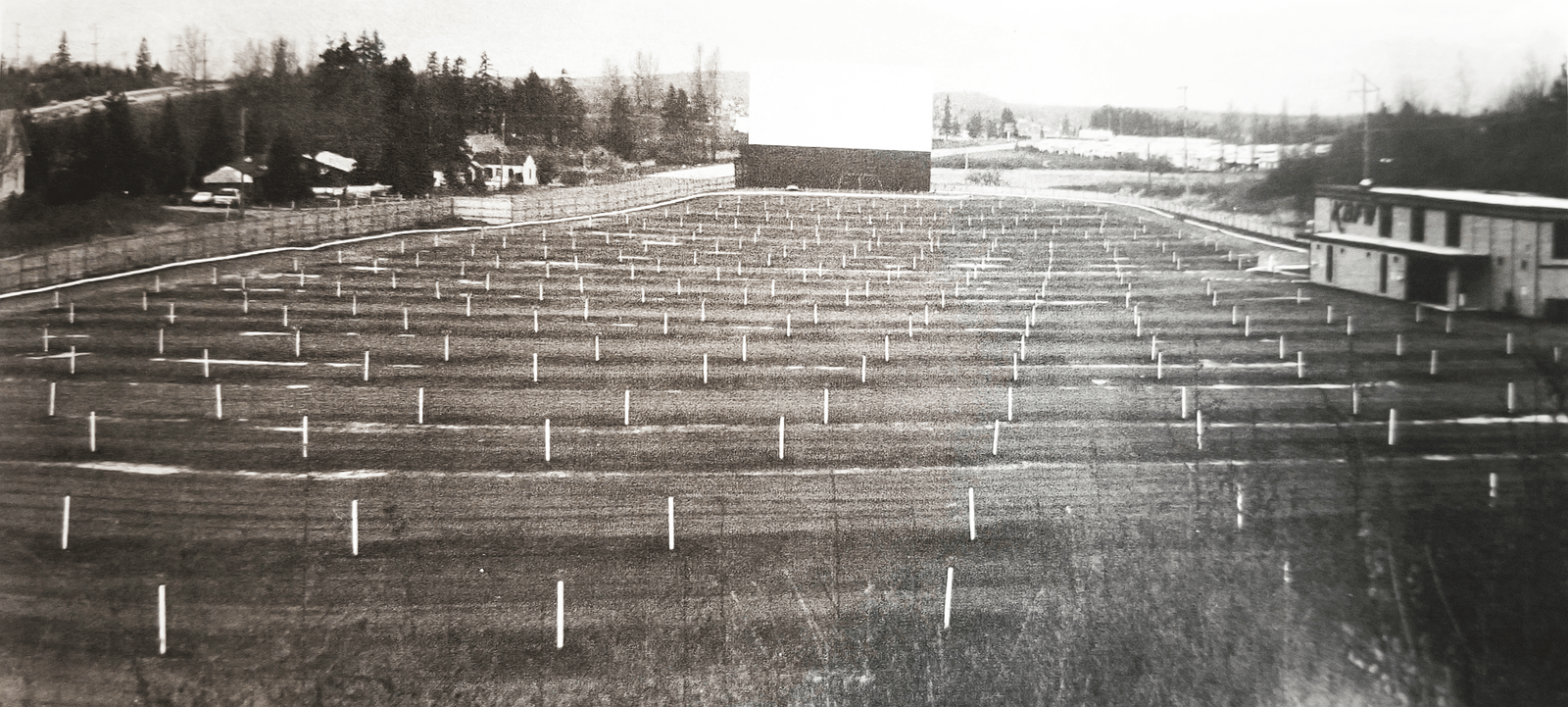
The photo below is a shot from another angle, the north end of the building. This was taken in 1972, before the drive-in was modified to twin screens in 1978. At that time, the second screen was added at the south, the parking lot was split down the middle, cars were parked so movie-goers were pointed in opposite directions, and different movies played on each of the two screens. (When the projection booth was renovated, the KBFW call letters were moved down the building toward the south.)

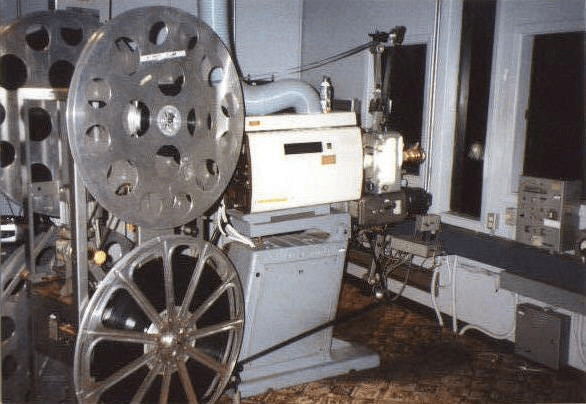
The drive-in had a huge parking lot with capacity for 600 vehicles. The ground floor of the shared building was dedicated to the drive-in. It included the snack bar that was open during the movies, and storage and minimal office space. The upper floor was all radio station, except for a projection booth at the building’s NW corner.
The layout of the front (west side) of the building is detailed in the photo below. The interior space, directly behind the KBFW call letters, was a large shared sales office/conference room that had up to four desks and a south-facing picture window. This photo was taken after the drive-in morphed into twin screens.
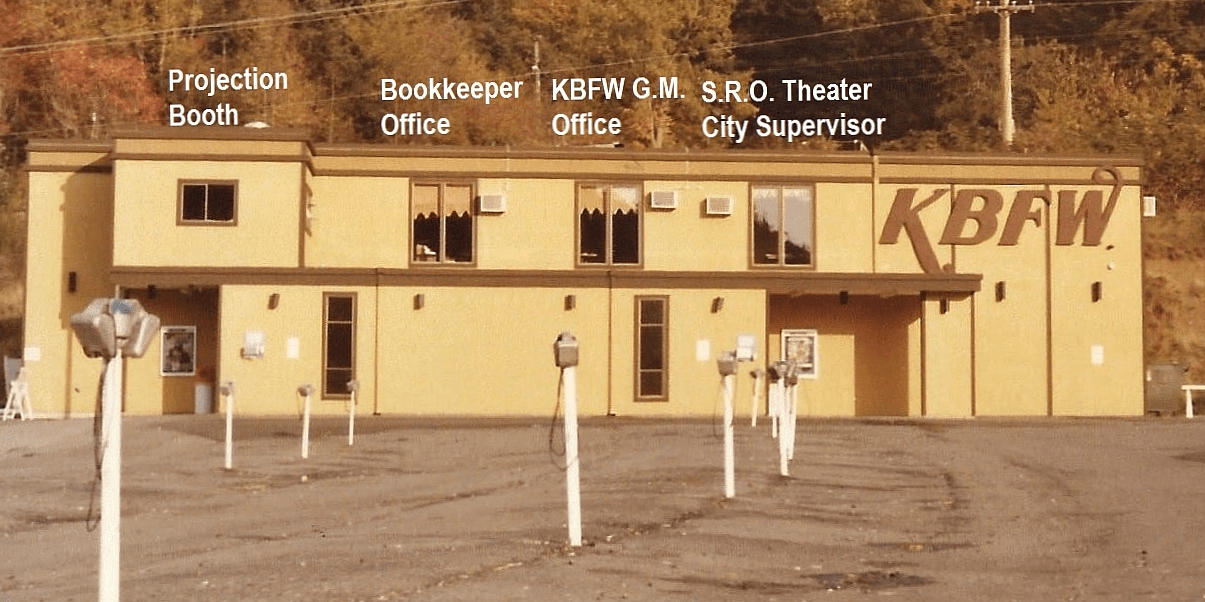
Here’s a floor plan that indicates the various rooms, with nooks and crannies, in our second floor studio. There was a spacious hallway down the center. Placement of the original movie screen is seen at the left (north end).

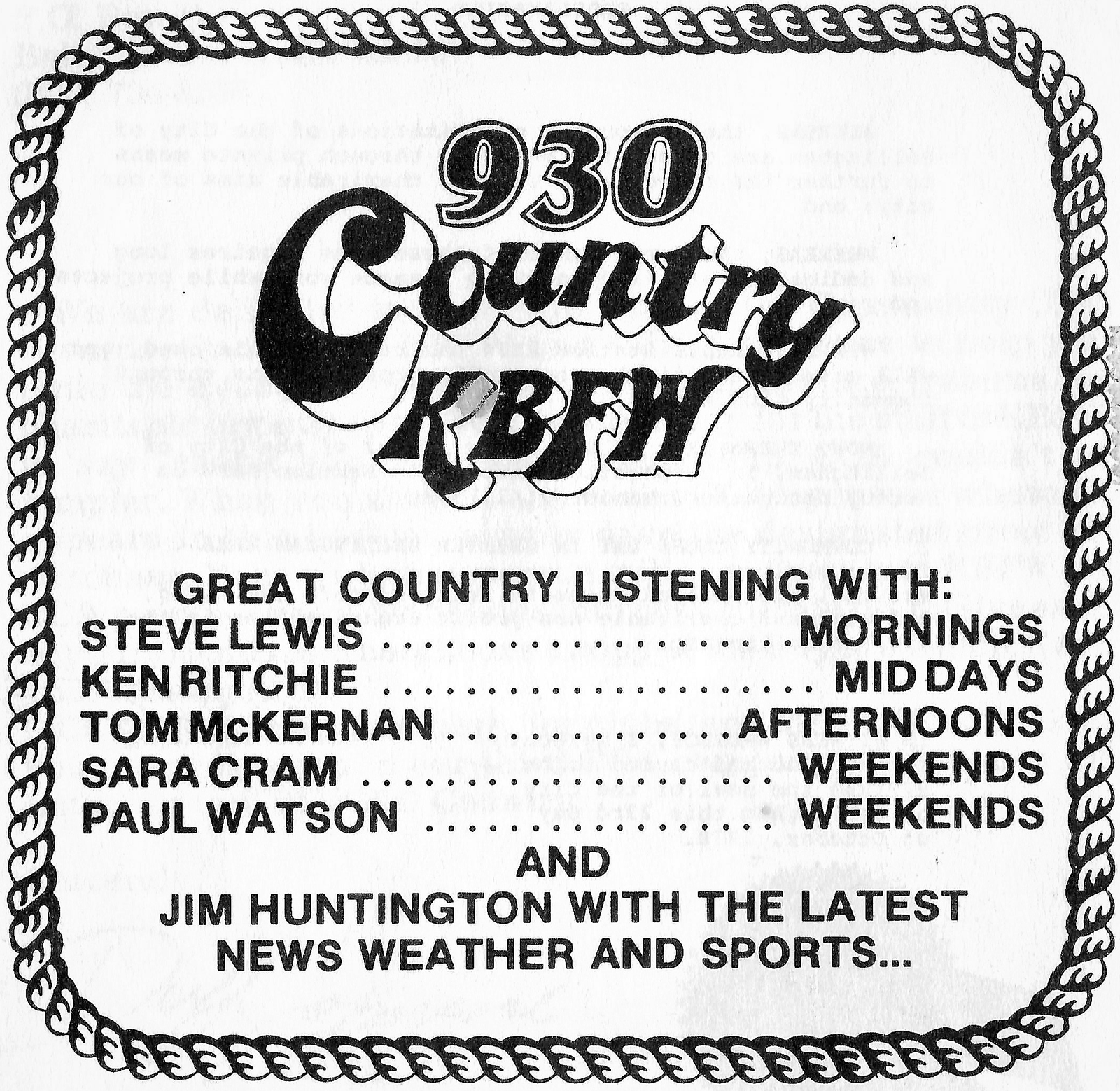 I worked for SRO from June 1972 until July 1985. In that time, I saw many managers sit in that GM’s office. Maybe broadcast veteran readers will recognize some of these names: James Speck, Terry Casten, Bob Wood, Bob Hensky, Don Opperman, Jack Chunn, Dave Fransen, Duff Johnson, Mike Nelson, Mike Cole, Peter Barnard and, lastly, yours truly. I was the GM for about two years and, as Fred Danz began to divest his holdings, a business partner (furniture retailer Ted DeWitt) and I purchased the station in July 1985. We sold KBFW to Saga Communications 14 years later.
I worked for SRO from June 1972 until July 1985. In that time, I saw many managers sit in that GM’s office. Maybe broadcast veteran readers will recognize some of these names: James Speck, Terry Casten, Bob Wood, Bob Hensky, Don Opperman, Jack Chunn, Dave Fransen, Duff Johnson, Mike Nelson, Mike Cole, Peter Barnard and, lastly, yours truly. I was the GM for about two years and, as Fred Danz began to divest his holdings, a business partner (furniture retailer Ted DeWitt) and I purchased the station in July 1985. We sold KBFW to Saga Communications 14 years later.
Those Were the Days
I am sharing a small portion of the pictures and audio I have collected over the years. The photo below was copied from the SRO Spotlight, the company newsletter, in the early ’80s. For reference, I was known as “Steve Lewis” on-air and as Steve Smith in my other capacities.
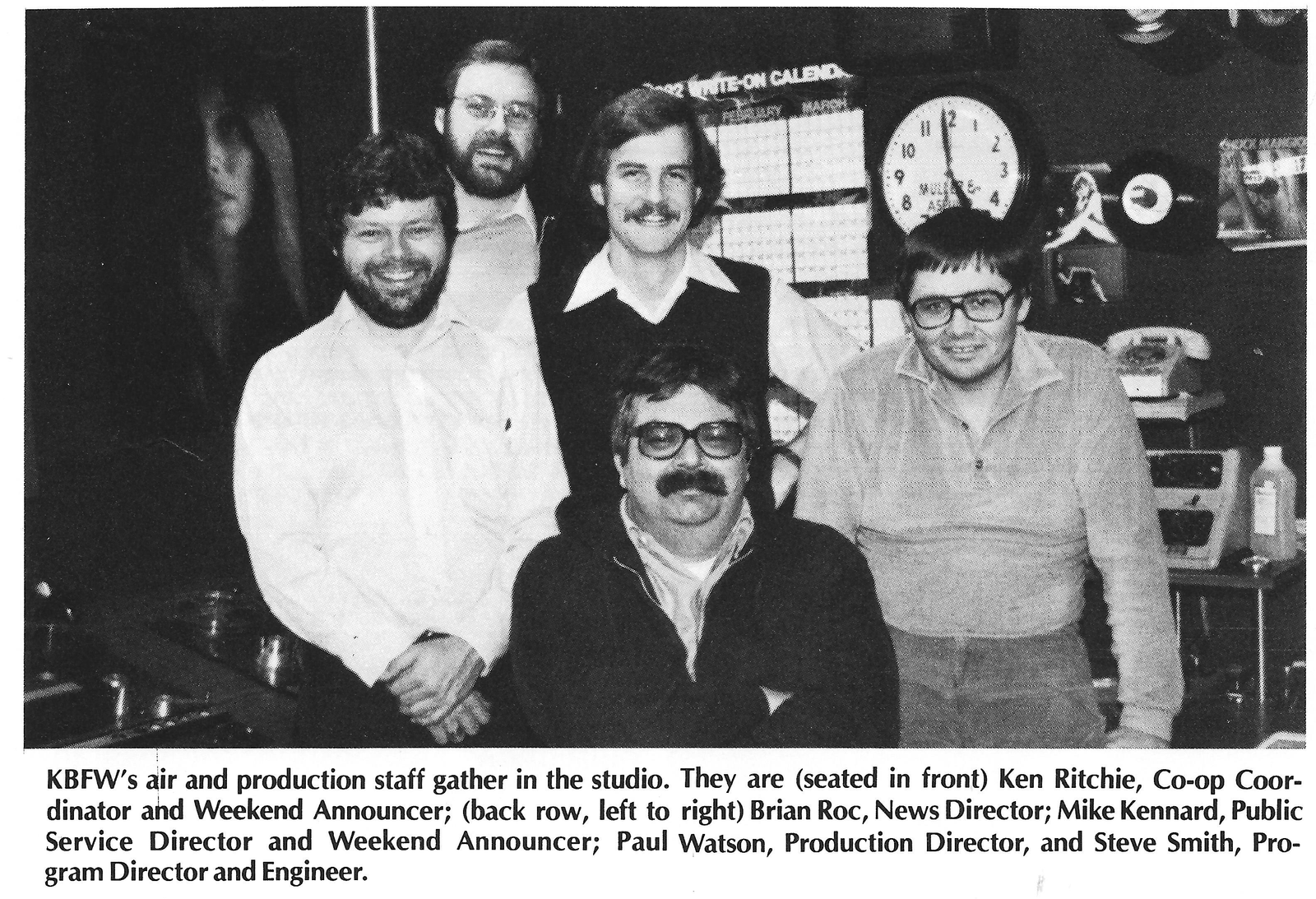
In the late 1970s, we had great promotional results when we ran a billboard campaign featuring Willie Nelson, Waylon Jennings, Anne Murray and Barbara Mandrell.

Speaking from experience, I thought working at the station when it was located at the drive-in was mostly fun. The snack bar offered KBFW staff discounts on popcorn, hot dogs and pizza. We promoted the drive-in on the radio and the drive-in promoted KBFW by piping tapes we produced into all the cars in the parking lot before the movie, at intermission and after the show. At the north end of our second floor studio, there was a movie viewing area with a big couch and a speaker. Radio station employees could watch movies (the quality of the shows being typical of drive-in fare), plus SRO provided staff with movie passes that were valid at all SRO theaters in town. That was a nice benefit. At one point, SRO owned or managed every theater in Bellingham and there were several theaters. No small matter, SRO offered full-time employees decent health care and dental plans, which the company paid for. That was rare for most small radio stations.
 A memorable moment came when the drive-in was scheduled to show “A Clockwork Orange.” It was a controversial motion picture with kinky sex and violence, although most drive-in movies weren’t exactly great cinema. The Bellingham Police gave advance warning that if the movie was projected onto the screen, the local theater manager would be arrested and taken away in handcuffs. I was hanging around the theater that night, as were several cops and the city manager of all the SRO theaters. The city manager was pretty agitated and he insisted on running the movie up until the last minute, but in the end he balked and the screen faded to black as the show began.
A memorable moment came when the drive-in was scheduled to show “A Clockwork Orange.” It was a controversial motion picture with kinky sex and violence, although most drive-in movies weren’t exactly great cinema. The Bellingham Police gave advance warning that if the movie was projected onto the screen, the local theater manager would be arrested and taken away in handcuffs. I was hanging around the theater that night, as were several cops and the city manager of all the SRO theaters. The city manager was pretty agitated and he insisted on running the movie up until the last minute, but in the end he balked and the screen faded to black as the show began.
There was one big inconvenience associated with having a studio located at the drive-in theater: If an employee needed to get into the station after dusk on a movie night, it was an ordeal. You found yourself waiting in line behind all the movie-goers in cars. There was no “backdoor” way of getting your car into the station in an emergency. Trying to drive “in” the “out” gate resulted in built-in giant spike strips shredding your tires.
The next newspaper picture (Bellingham Herald, late ’80s) captured me perched in that same production room Jay Hamilton was photographed in previously. The big difference was that his 1972 photo predated mine by about 15 years.
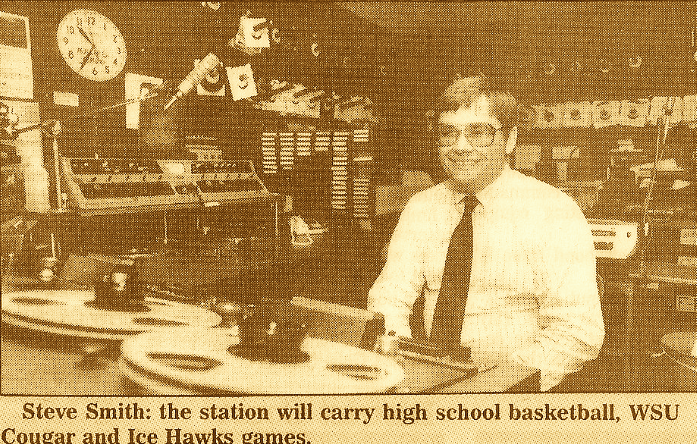
Maybe after subjecting you to that photo of me, I should show you another picture of Jay Hamilton….but this time in the newly set up control room at the drive-in. This was taken in the early ’70s shortly after our move to the drive-in. It is a reminder that once our engineer, Bill Hamelin, had the control room up and running, we could go back to cutting spots in our production room.

In those years, when AM radio was dominant, KBFW was the only country music station in the county. Into the early 1990s, we had a large following, consistently ranking at or near the top in the highly desirable 25-54 age demographic. I have retained a few audio cuts. The first one is about 48 years old. In 1972, I was a 19-year-old college student working evening and weekend deejay shifts. These are mainly “bits” or sketches that I recorded at the time. Some of the cuts will be more amusing if you happen to know the songs involved. I had forgotten about the last cut in this assortment. I never tried to be a shock jock, but it was really pushing the envelope for an adult station in that era. I left it in the mix anyway.
Audio Player

Next are a few KBFW jingles. Variations of this jingle package were first heard in the mid-70s.
Audio Player
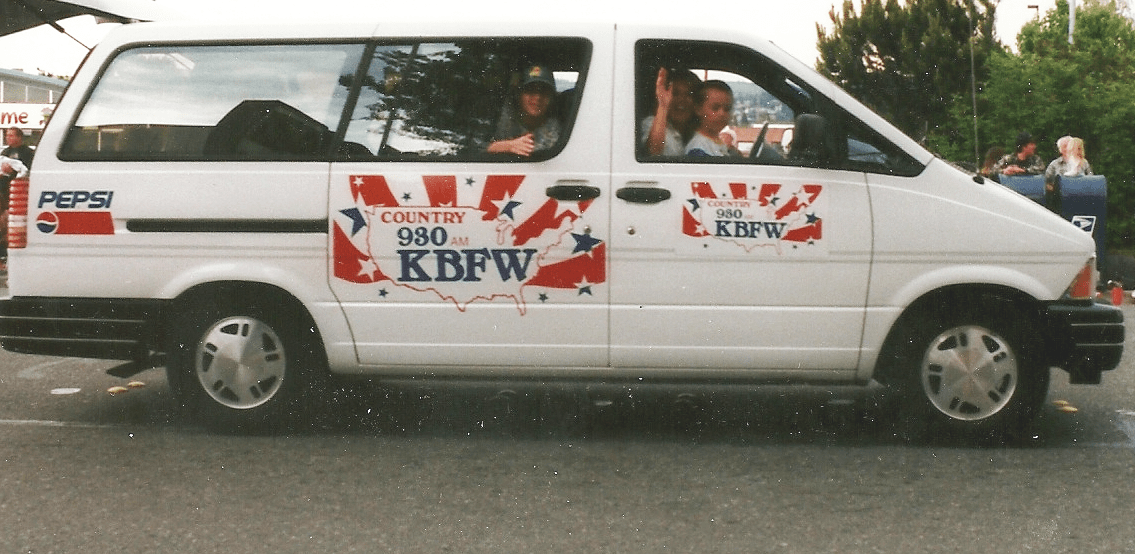
As an addendum, Fred Danz sold the Samish Drive-In property to Western Washington University circa 2003. It was turned into a student parking lot and the building has since been demolished. As I write this article, the wavy protrusions or ridges where cars were parked are still apparent in the texture of the parking lot. But, out of necessity, the speaker posts were all removed long ago.
Credits (Memorabilia): Jay Hamilton, Paul M. Watson, Chet Cory and the book Drive-Ins, Drive-Ups, and Drive-Thrus (In the History of Whatcom County) by Wes Gannaway and Kent Holsather, also the website Cinematreasures.org. Character voices by my friends Jerry Huddle & Don Wick.
Click on the names below to read about these broadcasters who were popular in Bellingham and Whatcom County, including nearby Canadian legend Red Robinson:
Danny Holiday (KPUG)
Dick Stark (KENY & KPUG)
Kirk Wilde (KPUG)
Gary Shannon (KPUG)
Mike Forney (KPUG)
Jay Hamilton (KPUG & KBFW)
Bob O’Neil & Marc Taylor (KPUG)
John Christopher Kowsky (KPUG)
Haines Faye & Rogan Jones (KVOS & KGMI)
Tom Haveman (KENY & KVOS)
Red Robinson (Vancouver B.C.)


January 16, 2025 at QZVX
Lee Mielke says:
I remember the smell of popcorn whenever I had to either pick up or deliver a recorded commercial that was to be used on KLYN where I worked. Good memories. I remember that Ted Dewitt owned KBFW for a time, didn’t he?
January 16, 2025 at QZVX
Steven Smith says:
Lee….Ted DeWitt and I were equal partners in ownership. We owned it together for about 15 years, buying KBFW from Fred Danz of SRO Theaters in the ’80s. We inked a sales deal with SAGA in 1998, sale closed in spring 1999. I had been with the station for many years, engineer, operations manager and GM, and Ted was a leading furniture retailer. It worked out great. We never had a disagreement that wasn’t minor and inconsequential.
December 2, 2024 at QZVX
Chet Cory says:
I was thrilled to be doing sports play-by-play of the Bellingham Ice Hawks hockey team in the 1990s as well as sprint car racing from Skagit Speedway. Both were KBFW exclusives and very popular. I started in 1983 as a weekender before going full-time in 1984 and was on the final broadcast in May of 1999.
December 3, 2024 at QZVX
Steven Smith says:
Chet…you did a great job. You knew how to do play by play of hockey and auto racing….two sports that many sportscasters know little about.
September 11, 2024 at QZVX
Michael Brown says:
Steve, I doubt you’ll remember me, but I did my college internship at KBFW in the spring of 1980. At the end you offered me the Sunday overnight shift, which I declined. My ego directed me to return home to the Seattle area because I thought I’d do better there. Hah! Never worked in broadcasting again. But I did find my way in life and eventually became a public school teacher for 32 years and retired in 2020. I remember you, Brian Roc, and Paul Watson well. Cheers, and best wishes.
September 12, 2024 at QZVX
Steven Smith says:
Mike…my memory is pretty good. When I saw your name yesterday I actually wondered if it was you. We wanted to hire you but as I recall Dan Jurgenson at Dairy Queen wanted you too and you ended up there. I recall he phoned me saying he really wanted you as an assistant manager or something like that. I also have a thought that you aspired to be a classical music announcer like at then KING Fm. I still see Brian who is in town here and I Email with Paul. Great to hear you check in.
June 6, 2021 at QZVX
Steven Smith says:
Les…I remember you well. I think you were somewhere around maybe helping us pack a bit that night we moved from the Tower to the Samish. Both Jim Speck and Jack Chunn passed away in the last 3 or 4 years.
June 6, 2021 at QZVX
Les Savitch says:
What an article. It sure brings back memories. I owned an ad agency that ultimately moved to Seattle about the same time Jack Chunn moved to a Seattle SRO station. Steve, I’d wondered what became of you. Feel free to give me a buzz. Les Savitch 509-308-0847.